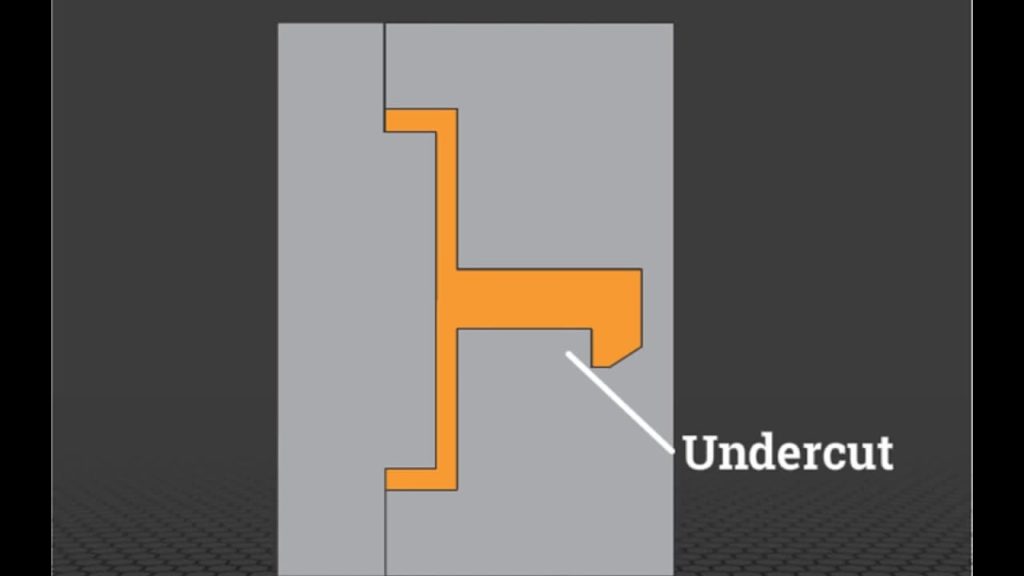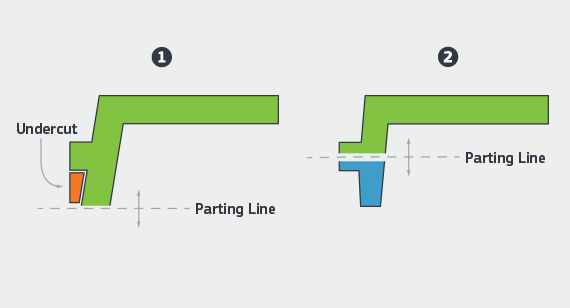Have you ever wondered how complex plastic parts with intricate details are made? The answer lies in a clever technique called injection molding undercuts. But what exactly are undercuts, and why are they so important?
Undercuts are features that prevent the easy removal of a part from its mold. They're crucial for creating parts with enhanced functionality, improved assembly, and reduced need for secondary operations. However, designing and molding undercuts comes with its own set of challenges.
In this post, you'll learn what undercuts are, why they are important, and how to manage their complexities effectively.
What are Injection Molding Undercuts?
Injection molding undercuts are features that prevent a part from being easily ejected from its mold. They're like hooks or overhangs that "lock" the part in place. Let's explore them in detail.
Detailed Explanation of Undercuts
Undercuts are typically formed when a part has:
Protrusions
Holes
Cavities
Recessed areas
These features aren't perpendicular to the mold's parting line. This makes it challenging to remove the part without damaging it.
Types of Undercuts
There are two main types of undercuts:
Internal undercuts
External undercuts
Found on the outer surface
Examples: clips, hooks, flanges

Common Applications
Undercuts are used in various industries for:
Consumer electronics
Button slots
Battery compartments
Medical devices
Luer locks
Snap-fit assemblies
Automotive components
Clips and fasteners
Fluid channels
| Industry | Application | Benefit |
| Electronics | Button slots | Easy access |
| Medical | Luer locks | Secure connection |
| Automotive | Clips | Quick assembly |
Undercuts add functionality and simplify assembly. They're a key aspect of injection molding design.
Importance of Undercuts in Injection Molded Parts
Undercuts play a crucial role in injection molded parts. They offer several benefits that make them indispensable in modern manufacturing.
Enhanced Functionality and Design Complexity
Undercuts allow designers to create parts with:
Intricate geometries
Interlocking features
Snap-fits and hinges
These elements enhance the functionality of the part. They also enable more complex designs that would be impossible without undercuts.
Improved Assembly and Disassembly
Undercuts facilitate easy assembly and disassembly of parts. They allow for:
Quick snap-fit connections
Reduced need for screws or adhesives
Easy replacement of worn or damaged components
This streamlines the assembly process and makes maintenance a breeze.
Reduced Need for Secondary Operations
By incorporating undercuts directly into the molded part, you can:
Eliminate the need for post-molding drilling or machining
Reduce the number of assembly steps
Minimize the risk of human error
This saves time, effort, and resources in the manufacturing process.
Cost-Effectiveness in Mass Production
Undercuts contribute to cost-effectiveness, especially in high-volume production runs. They enable:
Faster cycle times
Reduced material waste
Lower assembly costs
Over time, these savings add up, making undercuts an economical choice for mass production.
| Benefit | Impact |
| Enhanced functionality | Enables complex designs |
| Improved assembly | Streamlines production |
| Reduced secondary ops | Saves time and resources |
| Cost-effectiveness | Lowers overall expenses |
Techniques for Achieving Injection Molding Undercuts
Creating undercuts in injection molding requires specialized techniques. Let's explore the most common methods and their pros and cons.
1. Parting Line Adjustment
Parting line placement is crucial for undercut design. It involves:
This allows the part to be ejected without interference.
Advantages:
Limitations:
Tips for optimizing parting line design:
Consider part functionality and aesthetics
Minimize the number of parting lines
Ensure proper venting and cooling

2. Side-Actions
Side-actions are movable mold components that create undercuts. They work by:
Types of side-actions:
Hydraulic - powered by hydraulic pressure
Mechanical - driven by cams or linkages
Pneumatic - actuated by compressed air
Design considerations:
Ensure proper clearance and alignment
Plan for adequate cooling and venting
Consider the force required to operate the side-action
Benefits:
Drawbacks:
3. Bump-Offs
Bump-offs are raised sections on the mold that compress during ejection. They allow the part to flex and release from the undercut.
Suitable materials for bump-offs:
Design guidelines:
Ensure sufficient draft angles
Use smooth, rounded surfaces
Consider the material's compression limits
Advantages:
Disadvantages:
4. Hand-Loaded Inserts
Hand-loaded inserts are manually placed in the mold before each cycle. They create undercuts by:
When to use hand-loaded inserts:
Design and material considerations:
Pros:
Cons:
5. Sliding Shutoffs (Telescoping Shutoffs)
Sliding shutoffs are mold components that move parallel to the ejection direction. They create undercuts by:
Applications:
Design tips:
Ensure proper alignment and clearance
Use wear-resistant materials for the shutoff surfaces
Plan for adequate cooling and venting
Advantages:
Limitations:
6. Collapsible Cores
Collapsible cores are mold components that collapse or retract during ejection. They allow the part to release from internal undercuts.
Types of collapsible cores:
Mechanical - driven by cams or linkages
Hydraulic - actuated by hydraulic pressure
Design considerations:
Ensure proper alignment and timing of the core movement
Plan for adequate cooling and venting
Consider the force required to collapse the core
Benefits:
Drawbacks:
Choosing the right technique depends on factors like:
Design Considerations for Undercuts
When designing parts with undercuts, there are several key factors to keep in mind. Let's explore them in detail.
Draft Angles
Importance of Draft Angles
Draft angles are crucial for undercut design. They help ensure:
Without proper draft, parts can stick or deform during ejection.
Recommended Draft Angles
The optimal draft angle depends on the specific design. However, here are some general guidelines:
| Feature Type | Recommended Draft |
| External walls | 1-2 degrees |
| Internal walls | 2-3 degrees |
| Ribs and bosses | 0.5-1 degree per side |
Increasing draft angles can improve part release but may affect aesthetics.
Wall Thickness
Maintaining Uniform Wall Thickness
Consistent wall thickness is essential for undercut design. It ensures:
Always follow the resin manufacturer's guidelines for wall thickness.
Impact on Part Integrity
Variations in wall thickness can lead to:
Weak spots or stress concentrations
Uneven material flow and packing
Visible defects on the part surface
Maintain a uniform thickness throughout the part for optimal results.
Ribs and Radiuses
Supporting Structures in Molded Parts
Ribs are thin, wall-like features that provide structural support. They help:
Reinforce large, flat surfaces
Prevent sink marks and warping
Improve part rigidity and strength
Use ribs strategically to enhance the performance of undercut parts.
Radiusing Internal Corners
Sharp internal corners are prone to stress concentrations. To mitigate this:
Radiused corners distribute stress more evenly, improving part durability.
Designing for Manufacturability (DFM) in Undercut Injection Molding
DFM is a crucial aspect of successful undercut design. Let's dive into its principles and benefits.
Overview of DFM Principles
DFM is a design approach that focuses on ease of manufacturing. Its key principles include:
Simplifying part geometry
Minimizing the number of components
Designing for efficient assembly
Considering material properties and limitations
By applying DFM, designers can create parts that are easier and cheaper to produce.
Importance of DFM in Undercut Design
Undercuts add complexity to the injection molding process. DFM helps manage this complexity by:
Identifying potential manufacturing issues early in the design phase
Optimizing part geometry for specific molding techniques
Ensuring the design is compatible with the chosen material
Reducing the risk of defects and production delays
Incorporating DFM is essential for successful undercut design.
Common DFM Guidelines for Undercuts
Here are some key DFM tips for designing undercuts:
Minimize undercut depth and complexity
Use consistent wall thickness throughout the part
Provide adequate draft angles for easy ejection
Avoid sharp corners and edges
Consider the parting line location and its impact on the undercut
Use standard materials and tolerances whenever possible
Following these guidelines can help streamline the molding process.
Benefits of Incorporating DFM
Implementing DFM in undercut design offers several advantages:
Reduced production costs and lead times
Improved part quality and consistency
Enhanced collaboration between design and manufacturing teams
Faster time-to-market for new products
Increased overall manufacturing efficiency
| DFM Benefit | Impact |
| Lower costs | More competitive pricing |
| Faster production | Shorter lead times |
| Better quality | Higher customer satisfaction |
| Enhanced efficiency | Increased profitability |
Challenges and Solutions
Designing and molding undercuts comes with its fair share of challenges. Let's explore some common issues and their solutions.
Material and Design Challenges
Managing Rigid Materials and Complex Geometries
Rigid materials like polycarbonate and ABS can be challenging for undercut design. They:
Complex geometries with deep or narrow undercuts further complicate the process.
Solutions to Common Design Issues
To overcome these challenges, designers can:
Use more flexible materials like TPE or nylon
Optimize wall thickness and draft angles
Incorporate side-actions or collapsible cores for complex features
Collaboration between designers and molders is key to finding effective solutions.
Aesthetic and Functional Considerations
Dealing with Visible Parting Lines
Parting lines are often visible on parts with undercuts. They can:
To minimize their impact, consider:
Adjusting the parting line location
Using texture or color to hide the lines
Employing sliding shutoffs for a seamless appearance
Ensuring Functional Integrity
Undercuts can also affect the functional performance of the part. To maintain integrity:
Conduct thorough design reviews and simulations
Test prototypes under real-world conditions
Make necessary design adjustments based on feedback
Finding the right balance between functionality and manufacturability is crucial.
Cost Implications
Balancing Complexity and Production Costs
More complex undercuts generally mean higher production costs. This is due to:
Increased mold complexity and maintenance
Longer cycle times and higher material usage
Additional labor for hand-loaded inserts or secondary operations
Designers must weigh the benefits of undercuts against their cost impact.
Long-Term Impacts on Investment
The upfront investment in a complex mold with undercuts can be significant. However, it's important to consider:
A well-designed undercut can pay off in the long run, despite initial costs.
| Challenge | Solution |
| Rigid materials | Use flexible alternatives |
| Visible parting lines | Adjust location or use texture |
| Functional integrity | Conduct thorough testing |
| Production costs | Balance complexity and benefits |
Summary
In summary, achieving injection molding undercuts involves several key techniques. We explored parting lines, side-actions, bumpoffs, hand-loaded inserts, and telescoping shutoffs. Selecting the right technique is crucial for success. Material choice and Design for Manufacturability (DFM) are also vital in undercut molding. Collaborating with experts ensures the best results. Effective undercut design requires both knowledge and precision.
Have a complex undercut design? Team Mfg has the expertise to bring it to life. Submit your CAD files today at https://www.team-mfg.com for a fast, free quote. Our experts are ready to assist you. Get started now!











